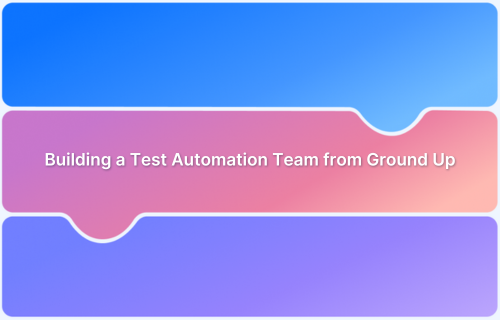Pair Testing: A Beginner’s Guide
By Shreya Bose, Community Contributor - October 10, 2024
Pair Testing is exactly what it sounds like. Two people sit at a single machine and work together to complete and evaluate a single test. Essentially, a single task is divided between two individuals who exchange ideas, discuss test scenarios, take notes, and generally collaborate to test software functionality. It is a form of exploratory testing.
What is Pair Testing?
Pair Testing is a collaborative approach to software testing where two testers work together at the same workstation. One tester typically focuses on writing test cases and executing them, while the other observes, provides feedback, and suggests additional test scenarios.
This method promotes knowledge sharing, enhances creativity in testing, and often leads to the discovery of issues that might be missed by an individual tester.
Generally, the pair in pair tests comprise a developer and a tester. However, in some instances, a customer, business analyst, solution designer, or technical writer can also form part of the pair if the situation calls for it.
A typical example of a pair testing scenario would be as follows:
One person uses the mouse and keyboard to run the test. The other directs the test process, asks questions, makes suggestions, notes down results, leaves comments, and more. They do this while going through the functionality, usability, and designs of the application module under test.
How to Conduct Pair Testing: Steps
Ideally, pair testing should proceed in the following steps:
Step 1. Partner Up the Right People: Find two people comfortable with collaborating. The two people should have a sense of each other’s working styles, be able to communicate adequately, and see eye-to-eye on project goals.
Step 2. Allocate Space: The duo should have access to a quiet room where they can talk (and not disturb anyone else) as well as the required machine for one or two hours.
Step 3. Establish Goals: Even though pair testing is a form of ad-hoc testing, testers shouldn’t be completely unstructured when approaching it. At the very least, formulate a list of software areas to cover. For example, let’s say a pair is testing a new feature with multiple components. Testers should come prepared with a list of components to cover, expected results for each, and what the test intends to accomplish.
Step 4. Decide on Roles: Before starting, decide which of the pair will operate the machine (the driver) and who will direct the session (the navigator). The navigator takes the driver through the steps of the tests, suggests scenarios, takes notes, and swaps ideas. However, both parties should equally contribute ideas, suggestions, and concepts to enrich the test cases.
Step 5. Log Bugs and Take Notes: Once the session ends, log bugs, if any. Additionally, make detailed bug reports and note any unexpected discrepancies and anomalies that might have popped up.
When to Conduct Pair Testing
There are a few situations in which pair testing comes in handy:
- Short pair tests between team members to quickly validate software components and further collaboration.
- As a learning opportunity, pair tests are ideal. Assigning a new member or junior tester with a senior tester can help the former quickly come up to speed on the development lifecycle.
- Pair tests are also helpful in supporting collaboration among different roles and expand the purview of QA operations. Testers can pair up with designers to get a sense of the software’s visual significance and design relevant test scenarios. Similarly, testers can pair with business analysts to ascertain how a customer-facing feature can be enhanced to boost revenue streams and brand credibility.
- When bugs are identified, pair tests are perfect for bringing objectivity into the debugging process. With the second set of (preferably fresh) eyes on the job, it became much less likely for incorrect code to go unnoticed.
Recommended Read: Effective tips for managing remote QA team
Advantages of Pair Testing
Pair testing is a collaborative approach in software testing where two testers work together on the same testing task. Here are some advantages of using pair testing:
- Enhanced Collaboration & Communication: Two testers can share knowledge and insights, leading to a more thorough understanding of the application. Regular interactions foster better communication skills, and teamwork.
- Increased Coverage: With two sets of eyes, more scenarios and edge cases are likely to be considered, improving overall test coverage.
- Knowledge Sharing: Pair testing facilitates learning from each other’s strengths and experiences, which is beneficial for skill development.
- Immediate Feedback: Testers can provide real-time feedback, allowing for quicker identification and resolution of issues.
- Better Problem Solving: Two minds can generate more ideas and solutions, making it easier to tackle complex testing challenges.
- Reduced Blind Spots: Collaborating helps in identifying potential biases or assumptions that one tester might overlook.
- Faster Issue Detection: With collaborative efforts, defects can be found and reported sooner in the development process, leading to quicker fixes.
- Diverse Perspectives: The combination of diverse perspectives often results in more robust and higher-quality testing outcomes.
Limitations of Pair Testing
While pair testing has many advantages, it also comes with certain limitations:
- Increased Resource Usage: Pair testing requires two testers for a single task, which may not be efficient in terms of resource allocation, especially in smaller teams.
- Potential for Conflict: Different working styles or personalities may lead to disagreements or conflicts, which can hinder productivity.
- Limited Scope: If pairs do not rotate or collaborate with different testers, the diversity of thought may be limited, potentially leading to repetitive testing approaches.
- Coordination Challenges: Scheduling and coordinating time for pair testing can be difficult, particularly in teams with varying workloads.
- Skill Imbalance: If there’s a significant difference in expertise between the testers, the less experienced tester may feel intimidated or unable to contribute effectively.
- Time Constraints: In fast-paced environments, dedicating time to pair testing may not always be feasible, especially when deadlines are tight.
- Not Suitable for All Tasks: Certain testing tasks may not benefit from pair testing, such as highly repetitive or straightforward tasks where collaboration adds little value.
Best Practices of Pair Testing
Implementing pair testing effectively can enhance its benefits and mitigate potential drawbacks. Here are some best practices:
- Define Roles: Clearly assign roles (such as, driver and navigator) to ensure that both testers know their responsibilities during the session.
- Rotate Pairs: Regularly change pairings to expose team members to different perspectives and foster knowledge sharing.
- Set Clear Objectives: Before starting, establish specific goals for the session to maintain focus and direction.
- Use Effective Communication: Encourage open dialogue, active listening, and constructive feedback to create a collaborative environment.
- Keep Sessions Manageable: Schedule pair testing sessions that are long enough for effective collaboration but not so long that fatigue sets in. Breaks can help maintain focus.
- Document Findings: Ensure that both testers take notes during the session to capture insights, observations, and any identified issues.
- Incorporate Regular Reviews: After pair testing sessions, hold brief reviews to discuss what went well, what could be improved, and any lessons learned.
- Balance Skill Levels: Pair testers with varying levels of expertise to promote mentoring and knowledge transfer.
- Use Tools Wisely: Leverage testing tools that facilitate collaboration, such as shared test management systems like BrowerStack Test Management or real device cloud like BrowserStack Live.
- Encourage Creativity: Allow testers the freedom to explore unconventional testing methods and think outside the box.
- Adapt to Context: Be flexible in your approach; some tasks may benefit from pair testing more than others, so assess the context before proceeding.
The Role of Real Devices in Pair Testing
All pair tests have to be run on real browsers and devices. Emulators and simulators simply do not offer the real user conditions that software must run within, making the results of any tests run on them inaccurate.
Consider testing websites and apps on a real device cloud, preferably one that offers the latest devices, browsers, and OS versions. This applies to both manual testing and automation testing.
BrowserStack’s real device cloud provides 3500+ real browsers and devices for instant, on-demand testing. It also provides a cloud Selenium grid for automated testing, which can be accelerated by 10X with parallel testing.
The cloud also provides integrations with popular CI/CD tools such as Jira, Jenkins, TeamCity, Travis CI, and much more. Additionally, there are in-built debugging tools that let testers identify and resolve bugs immediately. BrowserStack also facilitates Cypress testing on 30+ browser versions with instant, hassle-free parallelization.
Pair Testing is a quick and easy way to examine software periodically through the software development lifecycle. It also furthers collaboration and creates healthy team dynamics, thus implementing central principles of Agile development.




